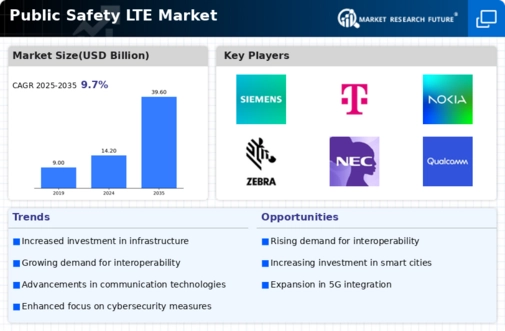Top Industry Leaders in the Public Safety LTE Market

Competitive Landscape of Public Safety LTE Market
The Public Safety LTE market is experiencing rapid growth, driven by increasing government investments in public safety infrastructure and the growing need for reliable and secure communication networks for emergency response agencies. This highly competitive landscape features a mix of established players and new entrants, each vying for a share of the market. Here's an overview of the key players, their strategies, and other factors shaping the competitive landscape:
Key Players:
- General Dynamics Corporation
- Airbus SE
- Motorola Solutions
- Cobham PLC
- Nokia Corporation
- Bittium
- Samsung Electronics
- Cisco Systems Inc.
- Telefonaktiebolaget LM Ericsson
- AT&T Inc.
Strategies Adopted:
Key players in the Public Safety LTE market are adopting various strategies to gain a competitive edge, including:
- Partnerships: Collaborating with public safety agencies, government bodies, and other technology providers to develop and deliver comprehensive solutions.
- Innovation: Investing in research and development to enhance network performance, security, and reliability, and develop new features and functionalities.
- Market Expansion: Expanding geographically to reach new markets and customer segments.
- Focus on Specific Segments: Targeting specific sub-segments within the market, such as law enforcement, fire services, or emergency medical services.
- Customization: Offering customized solutions to meet the specific needs and requirements of individual agencies.
Factors for Market Share Analysis:
Several factors are considered when analyzing market share in the Public Safety LTE market:
- Market size and growth: The size and growth potential of the overall market and specific segments.
- Product portfolio: The breadth and depth of a company's product portfolio, including core network, RAN, and end-user devices.
- Technological leadership: A company's position in terms of technological innovation and development.
- Customer base: The size and composition of a company's customer base, including public safety agencies, government bodies, and private companies.
- Financial performance: A company's financial health and profitability.
New and Emerging Companies:
Several new and emerging companies are entering the Public Safety LTE market, offering innovative solutions and challenging the dominance of established players. Some notable examples include:
- Avtec: A provider of ruggedized mobile devices and solutions for public safety and other critical industries.
- Cobham: A provider of mission-critical communications systems and solutions for defense, security, and space applications.
- Sepura: A provider of TETRA and LTE communication solutions for public safety and other mission-critical applications.
- Ascom: A provider of wireless communication solutions for healthcare, security, and industry.
- NICE: A provider of advanced software solutions for public safety and security applications.
Current Company Investment Trends:
Companies in the Public Safety LTE market are currently investing in several key areas:
- Network modernization: Upgrading existing networks to support LTE and next-generation technologies like 5G.
- Cybersecurity: Enhancing network security to protect against cyberattacks and data breaches.
- Interoperability: Ensuring that Public Safety LTE networks are interoperable with other communication systems, such as TETRA.
- Cloud-based solutions: Developing cloud-based solutions to improve network flexibility and scalability.
- Data analytics: Utilizing data analytics to gain insights into network performance and user behavior.
Latest Company Updates:
June 2023- New iBwave network survey solution is all set to target private LTE, public safety markets. This Canadian outfit has lately integrated a novel site survey & planning tool for the LTE based networks into their network design solution for enterprises, system integrators, and network operators. Their mobile survey application now has been integrated with the spectrum analyser solution and PRiSM handheld scanner from the US-based radio frequency engineering enterprise Epiq Solutions. Its objective is in further simplifying LTE network rollouts especially for the enterprises.
iBwave application functions on Android gadgets and has been made its footprint mostly based on the Wi-Fi network scanning. The integration with LTE-focused PRiSM software/hardware solution that magnetically attaches to the back of the tablet or phone plus with the other third-party scanning tools play into enterprise market for the private network, in particular. This PRiSM solution offers insights regarding benchmarking, interference, and network coverage and claims in bringing the power of expensive, large engineering tools to pocket friendly handheld devices.
Through wireless network survey data being a vital constituent of the design procedure, it is crucial that wireless engineers have scanners which are simple to use & can integrate seamlessly into the remaining of the network design life cycle. Again, it is also crucial that once the network gets deployed, the field technicians for the enterprises and operators are equipped with adequate tools for conducting troubleshooting checks and regular performance. This is particularly true for critical private LTE networks getting deployed via enterprises and carriers alike today.

